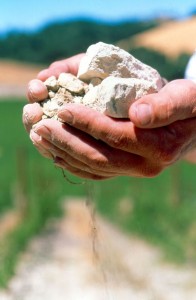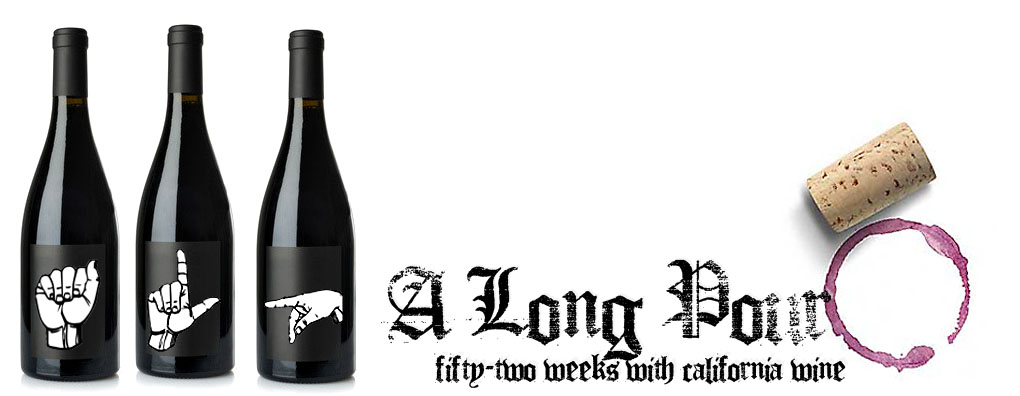“Why Limestone Matters for Wine Grape Growing” By: Jason Haas
It has long been cognized that great wine regions such as Champagne, Burgundy, Chablis, the Loire and southern Rhône valleys, and Saint-Emilion in Bordeaux are rich with limestone. Or, more precisely, these soils are rich in plant-accessible calcium carbonate, the principal chemical component of limestone, typically from decayed limestone outcroppings. (Limestone itself is too hard for plants’ roots to penetrate.)
Limestone is rare in California except in a crescent of land in the Central Coast between the Santa Cruz Mountains to the north and Lompoc to the south. When we were searching for a site on which to plant our vineyard, finding calcium-rich soil similar to that of Château de Beaucastel was a primary criterion. That calcium-rich soils were only found in the Central Coast focused our search in this area. The west side of Paso Robles and Templeton is the state’s largest exposed limestone layer, and in 1989 we bought our property here.
For all the anecdotal evidence of the superior qualities of calcium-rich soils, the science behind how calcareous soil influences grapevine health and the wines that come from them is still being explored. It turns out that there are four principal reasons why these soils improve wine quality.
 Water-retention capabilities
Water-retention capabilities
Calcium-based soils have water-retention properties that are ideal for growing grapevines. Some water is essential for cation exchange — the process by which plants take up nutrients through their roots. But grapevines do poorly in waterlogged soils, which increase the likelihood of root disease. Calcium-rich clay soils have a chemical structure composed of sheets of molecules held together in layers by ionic attractions. This structure permits the soil to retain moisture in periods of dry weather but allows for good drainage during heavy rains.
Soils that are less able to retain moisture must be irrigated. Drip irrigation creates a funnel-shaped wet area in the topsoil immediately under the dripper. As cation exchange cannot occur in the absence of moisture, the only roots that are taking up nutrients are those within the dripper zones. And as those zones are in topsoil rather than in deeper soils, it is clear why French regulations prohibit the use of irrigation in the top terroirs in France: wines from those vineyards would not be able to express their terroir.
At Tablas Creek, we have become more and more convinced that dry farming is perhaps the most important aspect to producing wines of place. And our calcium-rich soils mean we can dry farm, even though it almost never rains between April and November.
Cation exchange and berry pH
Calcium-based soils tend to be more basic than soils derived from other nutrients. The soil pH of the calcareous layers at Tablas Creek tends to be around 8, much higher than the typical topsoil pH of between 5.5 and 6.0. Research has shown that cation exchange is greater at higher levels of base saturation, perhaps because most of the minerals that grapevines require are at their most accessible when soils are more basic.
High-calcium soils are also correlated with easier nutrient uptake. The nutrients a grapevine needs to thrive (magnesium, potassium, calcium, and sodium) are taken up at certain specific sites on the root hairs through the process of cation exchange. Negatively charged compounds in plant roots attract positively charged cations. Calcium helps soil particles aggregate through a process called flocculation, which helps make available more cation exchange sites to a plant’s roots.
In low-pH soils, Hydrogen ions start to displace the ions of the four principal nutrients. Only above a pH of 6.0 are all four nutrients readily available. So, calcium carbonate acts as a buffer (it has been used for centuries as an antacid) and counteracts the acid created in the breakdown of organic matter in topsoil. The end result is a a pH level at which nutrient availability is at its highest.
Finally, there is increasing evidence that soils rich in calcium help maintain acidity in grapes late in the growing season. A researcher at the University of Bordeaux linked the healthy cation exchange processes in soils rich in calcium — and with enough water — to higher grape acidity and lower wine pH. And we have good anecdotal evidence of this property. At the symposium on Roussanne that we conducted two summers ago, producers from eastern Paso Robles, where calcium-rich soils are much rarer and rainfall consistently less, consistently reported harvesting Roussanne roughly half a pH point higher than those of us on the calcareous (and wetter) west side.
Root system and vine development
Unlike cereals and other annual crops that have shallow root systems, grape vines have deep root systems. This means that the composition of the deeper soil layers is more important for vine health and wine character than that of the topsoil. It also means that amending the soil (by, for example, liming to add calcium) is less effective than is natural replenishment of essential nutrients from deeper layers.
Grapevine roots are remarkable. They can penetrate dozens of feet into soil in their search for water and nutrients, and they continue to grow throughout the vines’ lives. This means that the physical properties of the soil are important: a hardpan layer through which roots cannot penetrate can have a serious negative impact on a vine’s output. Calcium’s tendency toward flocculation (soil particle aggregation) creates spaces into which roots can penetrate and in which water can be stored. This quality is particularly important with clay, and clays high in calcium tend to offer better soil structure and less mechanical resistance to roots than t hose without. In addition, in long periods of dry weather, the clays dry out and crack, allowing roots to penetrate deeper into the soil where more residual moisture can be found. And even in our vineyard (relatively young in vineyard terms) we’ve found roots ten feet deep and deeper in experimental excavations.
hose without. In addition, in long periods of dry weather, the clays dry out and crack, allowing roots to penetrate deeper into the soil where more residual moisture can be found. And even in our vineyard (relatively young in vineyard terms) we’ve found roots ten feet deep and deeper in experimental excavations.
In addition, soils where calcium is scarce — like those where water is unavailable — tend to show excessive exploratory root growth, and may have large, inefficient root systems that support small, relatively weak growth above ground. And this makes sense: vines have a certain amount of energy to apportion between root growth, canopy growth and berry ripening. If they are forced to invest more energy in searching for calcium there is less available for other tasks.
Disease resistance
Finally, there is evidence that calcium is essential for the formation of disease-resistant berries. Calcium is found in berries in its greatest concentration in the skins, and essential for the creation of strong cell walls and maintaining skin cohesion. However, if calcium is scarce, plants prioritize intracellular calcium over berry skin calcium and berries are more susceptible to enzyme attack and fungal diseases.
We’ve thought since the beginning that limestone was a key to making great wines. It’s great to learn the science that underpins our belief.
Anyone who is interested in the more detailed science behind this article should read the two-part piece by Valerie Saxton in Wine Business Monthly, from which I drew heavily for this article. You can find Part I and Part II online.
Jason Haas is General Manager of Tablas Creek Vineyard in Paso Robles. He also writes “Blog Tablas Creek” which has been consistently recognized as one of the top vineyard blogs in the Country.


